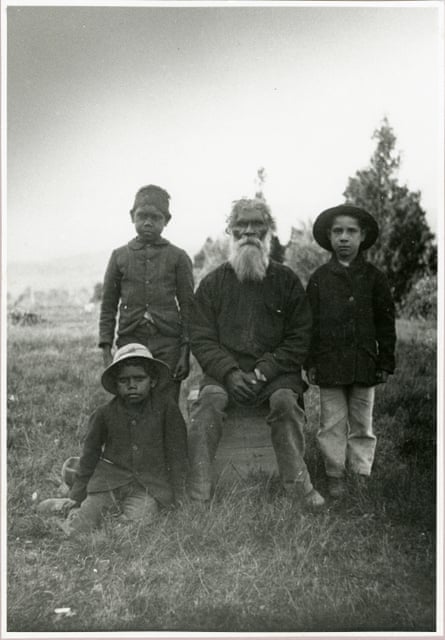One of Melbourne’s Aboriginal heritage councils is facing a race against the clock, in a bid to stop two culturally significant artworks being lost to Australia when they go under the hammer at Sotheby’s New York auction house next week.
The two works – an earth pigment and charcoal on paper painting, and a carved hardwood parrying shield – were created by William Barak, a pivotal Wurundjeri ngurungaeta (leader), negotiator and artist in the mid to late 1800s.
The Wurundjeri Woi Wurrung Cultural Heritage Corporation has launched a GoFundMe campaign to raise money to buy the works at auction and return them to Australia, having only learned of the artefacts’ impending auction in late April. The auction is scheduled for 25 May.
A Wurundjeri elder and Barak descendent, Uncle Ron Jones, told Guardian Australia that the works should be classified as national treasures.
“Whether the government’s Liberal or Labor, state or federal, it should be governments’ responsibility, [these works] are part of our history and should be protected,” he said.
“We were wholly impacted [by colonisation] in virtually a similar way Tasmania was devastated. Let’s try and preserve some of our history and bring it back home.”
The 1897 painting titled Corroboree (Women in possum skin cloaks), has an estimated value of about A$500,000 according to the Sotheby’s online catalogue, while the shield has an estimate of about $35,000.
However, the Wurundjeri Corporation chief executive, Gwyneth Elsum said it had been advised as much as $1m might need to be raised to secure successful bids at auction.

“We don’t know exactly how much they will both go for, so we’ve just put in our estimate,” she said. “As we get closer to the auction, we will have a better sense of what they’ll actually go for.”
Elsum said the corporation wrote to Victoria’s Aboriginal affairs minister, Gabrielle Williams, on 22 April, seeking a meeting to discuss how the state government could assist in bringing the artworks home. A meeting has not been set.
In a statement, a spokesperson for the minister said that, under the Aboriginal Heritage Act, Victoria is only responsible for the repatriation of ancestral remains and sacred objects to their rightful owners within the state.
“The commonwealth government has responsibility for the protection and repatriation of significant cultural objects from overseas as part of the national heritage of all Australians,” the spokesperson said.
Barak is one of the Wurundjeri clan’s most revered historical figures and a key player in negotiations between Indigenous Australians and Europeans in and around Melbourne (Narrm) in the 19th century.
As a teenager, he witnessed the meeting between his father, uncles and other Wurundjeri elders that resulted in John Batman acquiring much of the land that became the cities of Melbourne and Geelong. Barak spent much of his life peacefully fighting against this dispossession, employing written petitions, diplomacy and negotiating skills.
Th La Trobe University lecturer Nikita Vanderbyl, who completed her PhD thesis on Barak, said the two works were either bought by the Swiss grazier and agriculturalist Baron Frédéric Guillaume de Pury, or offered to the de Pury family by Barak as a gift or form of cultural exchange. The de Pury family had extensive land holdings in the Coranderrk region, where the Wurundjeri Woi Wurrung people, part of the larger Kulin nation, had relocated following European encroachment.
“The way I would describe the friendship is that it emerged out of almost necessity, because during this period of colonisation nothing was really fixed,” she said.
“Barak was bringing his family into [de Pury’s] world as much as they were bringing him into theirs … he was using this friendship as a way to maintain contact with his country. There are strong indications that that friendship resulted in other artworks that are now in the de Pury’s Swiss collection at Neuchatel.”
The Australian arm of the de Pury family donated its extensive Barak archives to the Yarra Ranges Regional Museum about a decade ago.
Sandra de Pury, who still owns and operates the Yeringberg wine estate in the Yarra Valley her ancestors established, told the Guardian her family was not close to the European-based de Purys, and that they had not made contact about the Barak works.
“We would love to see them come back to Australia, but short of donating to GoFundMe, which I fully intend to do, it’s a substantial amount of money,” de Pury said.
Jones said his ancestor gave many paintings as gifts to people he respected.
“The painting tells the story of his people, his culture and his history,” he said, of Corroboree. “He would have only given it to a special friend … as far as I’m concerned, that family has no right to make hundreds of thousands of dollars from something that was gifted to them.”
It was only long after Barak’s death in 1903 that his artistic career was widely recognised. Much of his art now sits in museums and galleries across Australia.
An exhibition commemorating his life was staged at the National Gallery of Victoria in 2003. Two years later, the William Barak bridge was constructed in Melbourne, and he was placed on the Victorian Aboriginal Heritage Roll in 2011.
This is not the first time the Wurundjeri Woi Wurrung Cultural Heritage Corporation has resorted to crowdfunding in an attempt to repatriate a Barak work. In 2016, Bonhams sold his painting Ceremony for A$512,400. The corporation did not raise enough funds to outbid the successful buyer, an anonymous private collector. Its whereabouts are now unknown.
